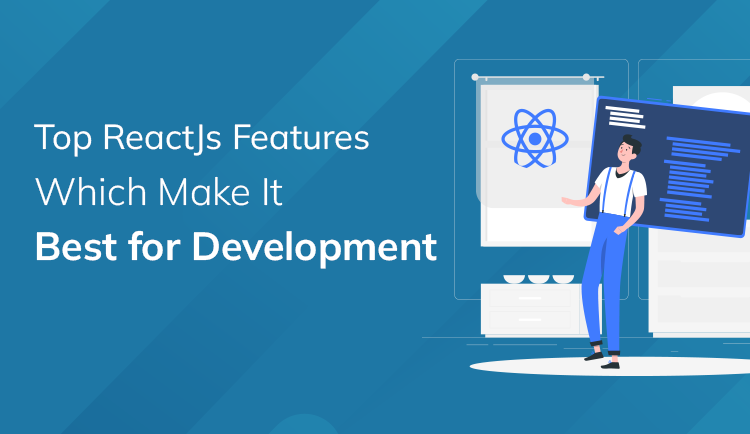
Top 10 ReactJs Features Which Make It Best for Development
Introduction:
With so many ReactJs best features, components, tools, and frameworks, front-end development is one of the most intriguing and flexible technologies. It is tough to select the appropriate and suitable instrument for an entrepreneur who is about to establish an internet business.
React Native is one of several frameworks for developing web and mobile apps. ReactJS is a JavaScript open-source framework that is declarative, efficient, and flexible. It is useful to construct simple, fast, and scalable front-end and single-page development programs.
React is a JavaScript framework that allows you to develop quick and interactive user interfaces for web and mobile apps. ReactJs best features are component-based, open-source front-end libraries that are exclusively responsible for the application’s view layer.
The view layer in Model View Controller (MVC) architecture is in charge of how the app appears and feels.
Benefits of using ReactJs:
React is a simple and lightweight JS library that solely handles the view layer. It is simple to implement and use. As you are aware, you can begin ReactJs best features by developing web applications with a basic understanding of JavaScript and a few more tutorials.
ReactJS is one of the simplest and easiest frameworks to understand when compared to other JavaScript frameworks. With JavaScript documentation that is simple to use and understand. So far, all developers who have used ReactJs best features for front-end development have found it to be simple to use and learn.
1. Easy construction of dynamic apps: –
When compared to JavaScript, React makes it easier to create dynamic web applications. It needs less coding and provides greater features.
2. Improved performance: –
The Virtual DOM analyses the past states of the components and updates just the elements in the Real DOM that have changed, rather than updating all of the components anew, as traditional web applications do.
3. Components: –
They are the building elements of any React application, and a single app is often made up of many components.
4. React has a low learning curve: –
Since it mixes core HTML and JavaScript ideas with some useful features. Still, like with other tools and frameworks, you must devote some effort to mastering React’s library.
ReactJS Best Features:
ReactJS allows you to make exact changes to the data in your web application without refreshing the page, which is why it is gaining popularity among users and developers for ReactJs best features.
Creating a user interface is simpler and faster. If you’re looking for a comparable service and want to build a robust web application for your company, you should consider working with a ReactJS development company.
Alternatively, if your requirements are limited, you should hire ReactJS developers to understand your needs and build your perfect solution.
1. Declarative:
ReactJs best features build highly interactive and dynamic user interfaces for web pages and mobile apps. Create basic views for each state of your application, and React will update and render only the necessary components when your data changes.
React uses simple JavaScript to enable a component-based approach to build websites and mobile applications, with the added benefit of lowering development costs. The library, on the other hand, is much easier to use when it is frequently applied to websites and apps.
2. DOM Virtualization:
ReactJs best features retain a lightweight version of the “actual” DOM in memory, which is referred to as the “virtual” DOM (VDOM). Because nothing is rendered on the screen when processing actual DOM, it is significantly slower than manipulating VDOM.
A virtual DOM object is a DOM object that produces a virtual replica of the actual DOM.
This is one of the most important factors to consider when developing a high-load application. However, ReactJS employs a virtual DOM for all of its components. ReactDOM updates and rents the actual DOM tree without any intervention from the programmer.
The developer first creates the application changes in this case, and then all changes are made on the virtual DOM. The React-DOM is updated if the changes are not risky and have no effect on performance.
3. Event handling:
React develops its own event system that is completely compliant with the W3C object model. Instances of Synthetic Event encapsulate all native browser events.As a result, you won’t have to worry about mismatched event names and fields.
Furthermore, the React event system is handled via event delegation and includes a pool of event objects to decrease memory cost.
4. Execution:
React leverages VDOM, which allows web apps to execute significantly quicker than those built with other front-end frameworks. React deconstructs a complicated user interface into separate components, allowing several users to work on each component at the same time, reducing development time.
5. Additions:
ReactJs best features go beyond simple UI design and include a plethora of modules that provide full application architectural support. It supports server-side rendering, which means that it renders a typically client-side-only web application on the server and then delivers a completely rendered page to the client. It also makes heavy use of Flux and Redux in web application development.
6. React Native:
As building blocks, React Native uses native components rather than web components like React. To get started with React Native, you need to be familiar with the fundamental React principles such as JSX, components, state, and props. Even if you’re familiar with React, you’ll need to learn about React Native-specific features, such as native components.
7. Component-Based:
In React everything is a component of the web page that is divided into small components to create a view (or UIs). Every visual aspect of the program would be housed within a self-contained module known as a component.
You can provide rich data while keeping the state out of the DOM since the component functionality is defined in JavaScript rather than templates.
The ReactJs best features components of the building blocks of any React application and a single app is frequently composed of several components. The very important component is essentially a user interface element. React divides the user interface into distinct, reusable components that may be processed independently.
8. Rendering on the server:
One of the primary aspects of ReactJs best features was launched at Facebook as a new language to speed up page load time and to avoid relying on component delivery. Because the browser is the recipient of the ready-to-deliver page, ReactJS allows the browser to render without waiting for all of the JavaScript to be stacked and performed.
Because ReactJS only allows pre-rendering the underlying states of React components at the server-side, this ReactJS feature helps the page stack faster. ReactJS’s development makes use of a language other than HTML, namely JavaScript.
9. Stability
ReactJs best features offer a solid foundation for leveraging downward data flow. You can make any progressions in child structure while the parent structure remains unchanged. As a result, if you, as a ReactJS designer, need to alter any object.
Because ReactJS only utilizes downward data flow, it has a more robust core. The parent frameworks are unaffected by changes to the child frameworks.
As a ReactJS developer, all you have to do to alter an object is modify the state, make the change, and then update it. This structure strengthens the code and guarantees that the program works smoothly.
10. One-way Data Binding:
React’s one-way data binding ensures that everything remains modular and quick. Because of the unidirectional data flow, when a developer creates a React project, child components are frequently nestled within parent components. If a developer can know where and when an issue arises, they will have better control over the ReactJs best features for the entire web application.
Conclusion:
Given its merits, it is apparent that ReactJS has a future in corporate software development. High-level applications are simple to build, and any data changes may be implemented frequently. Of course, you may utilize Virtual DOM to make your application quicker and more user-friendly.
Everything in React is a component; the entire homepage is separated into tiny sections that are blended together to create the display. The major ReactJS feature is the Virtual-DOM, which only supports one-way data binding, whereas AngularJS supports two-way data binding whenever the view changes.
It is most likely the best UI framework available on the market, allowing developers to easily create complex UI structures.
There are numerous Flux implementations available, including the brand new framework Relay. The Virtual DOM is ReactJs best features, which was not available in Angular, provides an additional benefit. ReactJS Development makes use of previously unseen technology.




